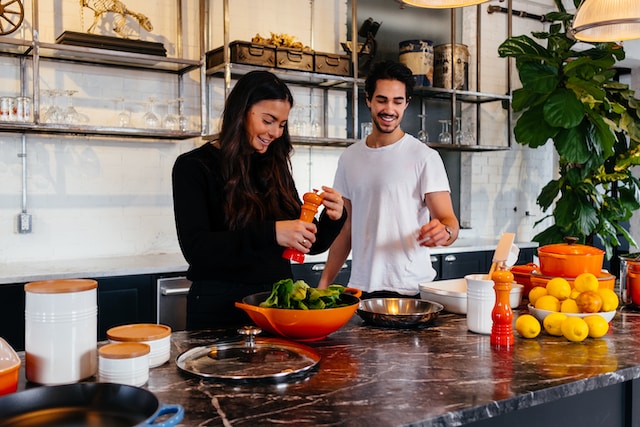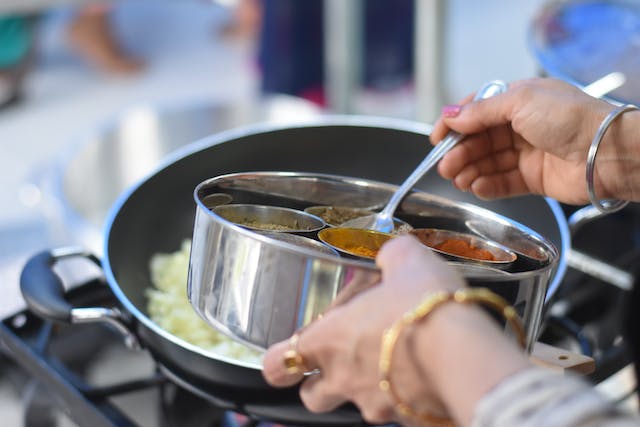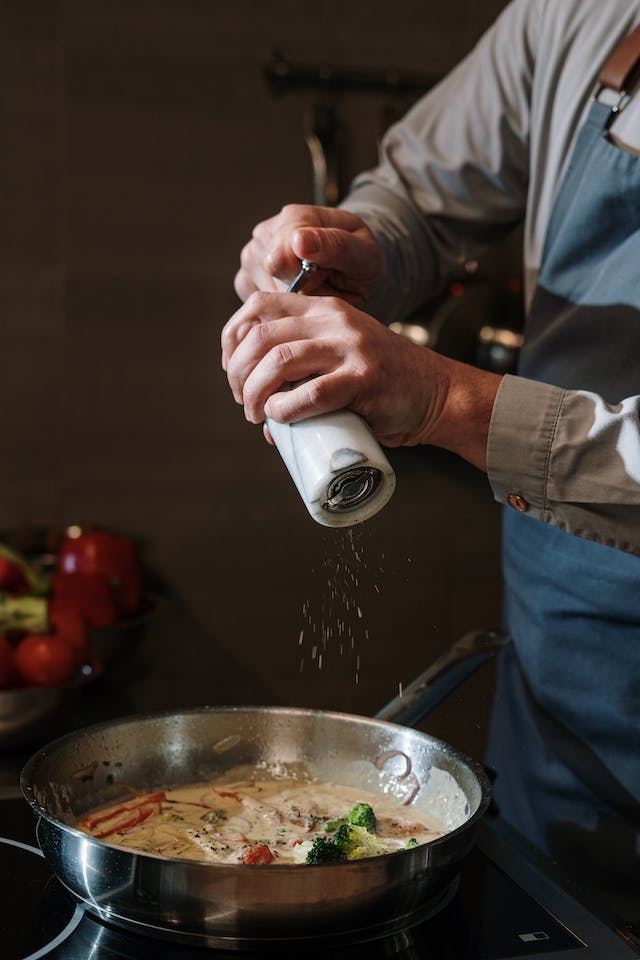
If you’re searching for a way to elevate your culinary creations without piling on unnecessary calories, then you’ve arrived at the right place. Spices not only provide a burst of flavors, aromas, and colors to your dishes. They also offer an extraordinary range of health benefits. In this guide, we will embark on an exploration of the incredible art of utilizing spices to transform the simplest of ingredients into exquisite feasts for the senses. So, grab your aprons and let’s dive into the tantalizing realm of healthy cooking with spices!
The Health Benefits of Cooking with Spices
Spices have been used for centuries not just to add flavor to our meals, but also for their remarkable health benefits. From improving digestion to boosting our immune systems, these small wonders have the power to transform our well-being from the inside out. So, let’s explore just a few of the many health benefits that cooking with spices can provide:
Rich in Antioxidants: Many spices are packed with antioxidants, which help to neutralize harmful free radicals in our bodies. These free radicals can damage cells and contribute to various diseases. By incorporating spices like turmeric, cinnamon, and clove into our dishes, we can reap the benefits of these potent antioxidants.
Anti-Inflammatory Properties: Inflammation is the body’s natural response to injury or infection, but chronic inflammation can lead to long-term health issues. Luckily, spices like ginger, cayenne pepper, and garlic possess powerful anti-inflammatory properties that can help reduce inflammation and alleviate symptoms associated with conditions such as arthritis and irritable bowel syndrome.
Improved Digestion: Many spices have been used for centuries to aid digestion and promote gut health. For example, cumin, fennel, and coriander can all stimulate enzyme secretion, enhance nutrient absorption, and relieve digestive discomfort. Incorporating these spices into your daily cooking can help keep your digestive system happy and functioning optimally.
Blood Sugar Regulation: Maintaining stable blood sugar levels is crucial for overall health, especially for those with diabetes or prediabetes. Spices like cinnamon, fenugreek, and turmeric have been shown to help regulate blood sugar levels and improve insulin sensitivity. Adding a dash of these spices to your meals can be a flavorful way to support balanced blood sugar control.
Immune-Boosting Properties: From the common cold to more serious infections, our immune system is at the forefront of defending our bodies. Spices such as garlic, ginger, and oregano have antimicrobial, antiviral, and antibacterial properties that can help strengthen our immune responses. By incorporating these spices into our cooking, we can give our immune system an extra boost.
Incorporating spices into our daily cooking not only adds depth and flavor to our dishes but also nourishes our bodies from within. With their wealth of health benefits, it’s no wonder these incredible ingredients have been cherished throughout history.
Selecting and Storing Spices
When it comes to selecting and storing spices, there are a few key factors to keep in mind to ensure maximum flavor and freshness in your culinary creations. Here are some simple guidelines to follow:

- Consider Whole versus Ground: Whole spices, such as cloves, peppercorns, and cinnamon sticks, have a longer shelf life and maintain their flavor more effectively than ground spices. It’s often best to buy whole spices and grind them as needed. Invest in a good spice grinder or mortar and pestle to achieve the most vibrant flavors.
- Quality Is Key: When choosing spices, prioritize high-quality options. Look for reputable brands or sources that offer fresh and pure spices without any additives or fillers. The quality of your spices will greatly impact the taste and aroma of your dishes.
- Storage Solutions: To protect your spices from moisture, heat, and light, store them in airtight containers in a cool, dry place. Avoid keeping them near the stove or in direct sunlight, as this can cause flavor deterioration. Additionally, make sure to label your containers with the spice name and the date of purchase to keep track of freshness.
- The Sniff Test: Over time, spices lose their potency and flavor. To check if your spices are still fresh, give them a sniff. If they lack the aromatic punch they once had, it may be time to replace them. As a general rule, ground spices remain fresh for about six months, while whole spices can last for one to two years.
- Buying in Small Quantities: Although it may be tempting to stock up on large quantities of spices, it’s best to buy smaller amounts more frequently. This ensures that you’re always cooking with the freshest spices possible. Plus, it gives you the opportunity to explore different flavors and experiment with exciting spice combinations.
Incorporating Spices into Everyday Cooking
Now that you understand the incredible health benefits of cooking with spices and have learned some helpful tips for selecting and storing them, let’s dive into the exciting realm of incorporating these flavor enhancers into your everyday cooking.
Begin by adding spices to your staple dishes. For instance, when preparing a simple tomato sauce, consider adding a pinch of dried oregano or basil for an aromatic twist. Or, when cooking your morning scrambled eggs, experiment with a sprinkle of paprika or a dash of cayenne pepper to awaken your taste buds.
Spices are the soul of international cuisines. From Indian curries to Moroccan tagines and Mexican salsas, each cuisine offers a unique blend of spices that will transport your taste buds to faraway lands.

Explore the vibrant flavors of garam masala, ras el hanout, or chili powder to add an exotic touch to your meals.
Balance is Key
When incorporating spices into your dishes, aim for balance. Remember that a little goes a long way, especially with potent spices like cayenne pepper or turmeric. Start with a smaller amount and gradually increase to achieve the desired level of flavor. It’s easier to add more spices later than to overpower your dish from the beginning. The goal is to enhance, not overpower, the natural flavors of your ingredients.
Experiment with Combinations
The beauty of cooking with spices lies in the infinite possibilities of flavor combinations. Don’t be afraid to get creative and mix different spices together to create your own signature blends. For example, try mixing cinnamon, nutmeg, and allspice for a warm and comforting flavor perfect for baked goods. Or, combine cumin, coriander, and paprika for a smoky spice blend that adds depth to roasted vegetables or grilled meats.
Spices are the perfect ingredient to create flavorful marinades and rubs for meats, poultry, or tofu. A simple mixture of garlic, ginger, soy sauce, and a hint of honey can transform a plain chicken breast into a mouthwatering feast. Allow your proteins to marinate for at least 30 minutes (or even overnight) to let the spices infuse and tenderize the food.
Elevate Your Beverages and Desserts
Spices aren’t just limited to savory dishes. They can also breathe life into your beverages and desserts. Consider adding a sprinkle of ground cinnamon or a pinch of cardamom to your morning coffee or hot cocoa for an aromatic wake-up call.

And when it comes to desserts, don’t forget about the classic pairing of spices like cinnamon and nutmeg with apples in a comforting pie or crumble. The possibilities are endless when it comes to incorporating spices into your sweet culinary creations.
Spice Blends and Mixes
Creating your own spice blends and mixes is a delightful way to elevate your culinary creations. By combining different spices, you can create unique flavor profiles that are tailored to your personal taste preferences. Here are a few simple spice blends and mixes to get you started on your creative journey:
Herbes de Provence: This classic French blend brings the flavors of the Mediterranean to your dishes. Combine dried thyme, rosemary, oregano, marjoram, and savory for a fragrant and versatile blend. Sprinkle it over roasted vegetables, rub it onto poultry or fish, or add it to homemade salad dressings.
Curry Powder: Bursting with vibrant flavors, curry powder is a staple in Indian cuisine. To make your own, combine ground coriander, cumin, turmeric, fenugreek, ginger, cinnamon, and cardamom. Adjust the quantities of each spice based on your preference for mild or spicy curries.
Italian Seasoning: This versatile blend is perfect for adding a touch of Italy to your dishes. Mix dried basil, oregano, rosemary, thyme, parsley, and garlic powder. Use it to season pizza, pasta sauces, or homemade bread.
Moroccan Spice Mix: Transport your taste buds to the exotic flavors of Morocco with this aromatic blend. Combine ground cumin, coriander, paprika, cinnamon, ginger, nutmeg, and black pepper. Use it as a rub for grilled meats, flavor couscous dishes, or season roasted vegetables.
Cajun Seasoning: Bring the fiery flavors of Louisiana to your kitchen with this zesty blend. Mix paprika, cayenne pepper, garlic powder, onion powder, dried oregano, dried thyme, and black pepper. Sprinkle it over grilled shrimp, add it to jambalaya, or use it as a seasoning for roasted potatoes.
Remember, these spice blends can be customized to suit your taste preferences. Feel free to experiment with different ratios and add or omit spices based on your flavor preferences. The key is to have fun and let your taste buds guide you on your culinary adventure.
To ensure the freshness and potency of your homemade spice blends, store them in airtight containers away from direct sunlight, heat, and humidity. Label each container with the name of the blend and the date it was made to keep track of freshness. Remember that spices lose their potency over time, so it’s best to use them within six months for optimal flavor.
Cooking Methods with Spices
Now that you have a repertoire of delicious spice blends at your disposal, let’s explore the various cooking methods that can truly bring out the flavors of these aromatic ingredients.

Sautéing: Sautéing is a quick and simple method that involves cooking ingredients in a small amount of fat over medium-high heat. Start by heating a touch of oil or butter in a skillet, then add your desired spices. As the spices sizzle in the hot pan, their flavors will bloom and infuse into the oil or butter. This technique works well for spices like cumin, mustard seeds, and curry powder, which release their flavors when gently heated.
Roasting: Roasting is a fantastic way to enhance the natural sweetness and depth of flavors in spices. Preheat your oven to a moderate temperature and spread your spices evenly over your chosen ingredient, whether it’s vegetables, meats, or even nuts. The dry heat of the oven will coax out the oils in the spices, resulting in a rich and aromatic dish.
Steaming: Steaming is a gentle cooking method that helps preserve the delicate flavors and nutritional properties of spices. Create a steam bath by adding water to a pot, placing a steamer basket on top, and bringing it to a simmer. Add your spices directly to the ingredients you’re steaming, such as fish, vegetables, or grains. As the steam permeates the food, it will carry the aromatic notes of the spices along, infusing every bite with deliciousness.
Slow Cooking: Slow cooking is the epitome of comfort and depth of flavor. Whether using a slow cooker or simmering on the stovetop, this method allows the spices to meld together with the other ingredients over a prolonged period. As the spices mingle with the liquids and heat, their flavors intensify and harmonize, resulting in a robust and savory dish. Perfect for spice blends like garam masala, chili powder, or herbes de Provence.
Grilling: Grilling adds a unique smoky flavor to your dishes and is an excellent method for imbuing spices onto meats, vegetables, and even fruits. Before grilling, rub your chosen spices into the food, ensuring they adhere to the surface. The high heat of the grill will awaken the flavors of the spices, creating irresistible charred aromas and caramelized crusts.
Stir-Frying: Stir-frying is a high-heat cooking technique that allows spices to infuse their flavors into the quickly cooked ingredients. Heat a small amount of oil in a wok or a large skillet over high heat, then toss in your spices and stir-fry for a few seconds until fragrant. Next, add your ingredients and continue cooking, stirring constantly. This method works well for spices like ginger, garlic, and chili flakes.
Remember, each cooking method brings its unique charm to the dish, so don’t be afraid to experiment and combine techniques. The goal is to create exceptional flavors that dance on your palate and keep you coming back for more.
